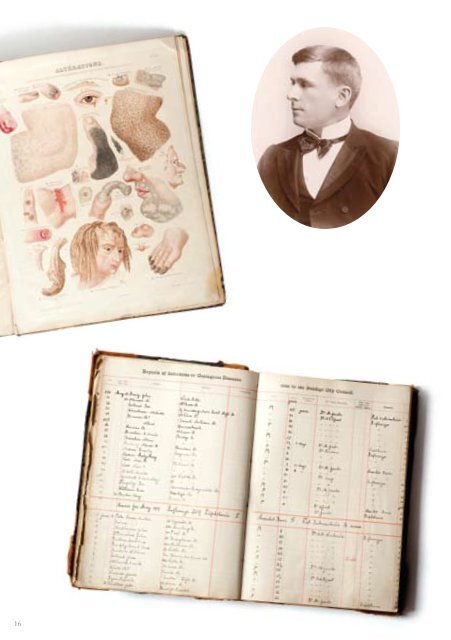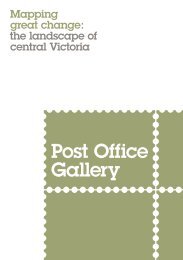A cure for all ills: medicine in Bendigo
This electronic publication accompanies the exhibition A cure for all ills: medicine in Bendigo. From chaotic beginnings to the formation of professional practice, the introduction of regulations against quackery and the establishment of long standing institutions such as Bendigo Hospital, A cure for all ills: medicine in Bendigo explored the social history surrounding the foundations of healthcare in Bendigo and the contribution of doctors, pharmacists, dentists, nurses and Chinese herbalists in providing essential health services to the community.
This electronic publication accompanies the exhibition A cure for all ills: medicine in Bendigo.
From chaotic beginnings to the formation of professional practice, the introduction of regulations against quackery and the establishment of long standing institutions such as Bendigo Hospital, A cure for all ills: medicine in Bendigo explored the social history surrounding the foundations of healthcare in Bendigo and the contribution of doctors, pharmacists, dentists, nurses and Chinese herbalists in providing essential health services to the community.
Create successful ePaper yourself
Turn your PDF publications into a flip-book with our unique Google optimized e-Paper software.
P. Rayer author<br />
Published by JB<br />
Bailiere, London<br />
Theoretical and practical<br />
treatise on the disease on<br />
the sk<strong>in</strong><br />
1935<br />
bound book<br />
Collection <strong>Bendigo</strong><br />
Health<br />
Dr John McIntyre Eadie<br />
late 19th century<br />
gelat<strong>in</strong> silver pr<strong>in</strong>t<br />
Courtesy Darren<br />
Wright<br />
City of <strong>Bendigo</strong> Reports<br />
of Infectious Diseases<br />
Register vol. 1<br />
1919–1941<br />
bound book<br />
Collection <strong>Bendigo</strong><br />
Regional Archives<br />
Centre<br />
VA2389 City of<br />
<strong>Bendigo</strong>/No VPRS<br />
number<br />
Bartlett Brothers<br />
<strong>Bendigo</strong> 1880 - 1900<br />
Infectious diseases<br />
nurses, <strong>Bendigo</strong> Hospital<br />
late 19th century<br />
gelat<strong>in</strong> silver pr<strong>in</strong>t<br />
Collection <strong>Bendigo</strong><br />
Health<br />
while reta<strong>in</strong><strong>in</strong>g the orig<strong>in</strong>al tooth<br />
with the subsequent hole filled with<br />
the newly developed substance<br />
amalgam; a material still prevalent <strong>in</strong><br />
contemporary dentistry. 24<br />
Infectious diseases<br />
One of the most significant<br />
developments <strong>in</strong> medical science has<br />
been the <strong>in</strong>troduction of antiseptics,<br />
and a greater understand<strong>in</strong>g of<br />
germs and disease. S<strong>in</strong>ce the 1950s,<br />
Australia has been almost entirely free<br />
from <strong>in</strong>fectious diseases <strong>in</strong> epidemic<br />
<strong>for</strong>m. This is due ma<strong>in</strong>ly to effective<br />
health education programmes, the<br />
<strong>in</strong>vention of vacc<strong>in</strong>es and subsequent<br />
free mass immunisation programs<br />
provided by municipal governments.<br />
In the often-squalid liv<strong>in</strong>g conditions<br />
of the early settlement of <strong>Bendigo</strong>,<br />
<strong>in</strong>fection was widespread. With little<br />
understand<strong>in</strong>g of how diseases started<br />
and spread, there were many deaths<br />
from diseases that today no longer<br />
exist or are easily treatable.<br />
In the late n<strong>in</strong>eteenth century,<br />
public health became a civic<br />
concern. A local Board of Health was<br />
established and from 1872 <strong>Bendigo</strong><br />
City Council, then Sandhurst,<br />
employed a Health Officer to<br />
monitor the health of the city. The<br />
first was Dr J Cruckshank who<br />
was succeeded <strong>in</strong> the 1880s by Dr<br />
John McIntyre Eadie, who reta<strong>in</strong>ed<br />
the appo<strong>in</strong>tment well <strong>in</strong>to the<br />
follow<strong>in</strong>g century. Health officers<br />
wrote quarterly and annual reports,<br />
provid<strong>in</strong>g a statistical breakdown of<br />
the health of the city. 25<br />
In Dr Eadie’s Annual Health<br />
Report <strong>for</strong> 1890, he notes that there<br />
were 1021 births and 600 deaths. He<br />
presents the causes of death <strong>in</strong> detail<br />
<strong>in</strong>clud<strong>in</strong>g six from Scarlat<strong>in</strong>a, n<strong>in</strong>e<br />
from Diphtheria, 12 from Typhoid<br />
Fever, 30 from Diarrhoea and 98<br />
from Phthisis. Often referred to as<br />
‘m<strong>in</strong>er’s compla<strong>in</strong>t’, Phthisis was<br />
a disease of the respiratory system<br />
much like Tuberculosis and resulted<br />
<strong>in</strong> the wast<strong>in</strong>g away or atrophy of<br />
the body; a disease Dr Eadie notes<br />
was the un<strong>for</strong>tunate side-effect of the<br />
‘unhealthy occupation of m<strong>in</strong><strong>in</strong>g’. 26<br />
By the turn of the century, deaths<br />
from Phthisis amongst adult m<strong>in</strong>ers<br />
<strong>in</strong> <strong>Bendigo</strong> were six times more<br />
frequent than among <strong>all</strong> Victorian<br />
adult males. 27<br />
Despite vastly improved liv<strong>in</strong>g<br />
conditions <strong>in</strong> the early years of<br />
the twentieth century, there was<br />
a dramatic <strong>in</strong>crease <strong>in</strong> <strong>in</strong>fection<br />
throughout the <strong>Bendigo</strong> region.<br />
16 17

















